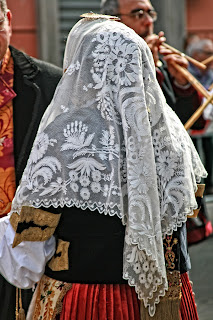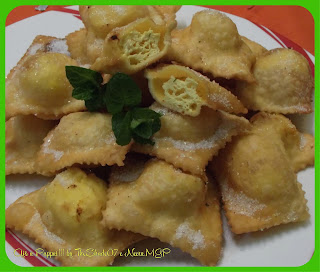Designing for the future: l'equilibrio perfetto tra tradizione ed innovazione
Alcune settimane fa il nostro amico Justas della CGTrader ci
ha invitate a partecipare al loro contest, avente come tema “Designing for the future: trends we need to
consider now”, ossia “Progettazione
per il futuro: le tendenze che dobbiamo considerare ora”.
Un tema molto interessante e attualissimo, dato che il
design non conosce né confini né tempi. Ma quali sono le tendenze che dobbiamo
considerare?
 |
| Complesso nuragico |
Il design è riconducibile ad ogni aspetto della storia e
della cultura sarda. Lo ritroviamo nelle costruzioni e nei metodi di
costruzione, dai nuraghi all’uso del
ladiri, un tipo di mattone che
potremmo benissimo definire “biodinamico e biologico” dato che nasce
dall’unione della terra con elementi vegetali di vario tipo, che rappresenta
l’elemento caratterizzante delle case tipiche campidanesi.
 |
| Giganti di Mont'e Prama |
 |
| Costume sardo |
Ma è con il connubio tra design e cibo che si eleva ancor di
più la nostra tradizione. Il design in questo ambito assume molti significati:
dalla presentazione delle varie portate e pietanze, agli ingredienti naturali e
dai sapori autentici, dai piatti e gli utensili alle forme di convivialità. Perché
è proprio attraverso la gastronomia,
l’agropastorale, l’ittica e la viticoltura che la Sardegna parla.
 Prendiamo, ad esempio, la manualità che si ritrova nei
diversi formati di pasta. Dai più
famosi malloreddusu e fregua, ai cruxioisi e filindeu, sino
ad arrivare ai culurgiones, con la
loro tipica chiusura a spiga, e alle lorighittas,
elegantissime nella loro fattura e realizzate con molte ore di lavoro a mano.
Prendiamo, ad esempio, la manualità che si ritrova nei
diversi formati di pasta. Dai più
famosi malloreddusu e fregua, ai cruxioisi e filindeu, sino
ad arrivare ai culurgiones, con la
loro tipica chiusura a spiga, e alle lorighittas,
elegantissime nella loro fattura e realizzate con molte ore di lavoro a mano.
Caratteristica è Sa
panada, un piatto unico in cui la pasta viene lavorata a mò di recipiente
ermetico e utilizzata per cuocere (a seconda dei gusti) carne, anguille o
verdure.
 |
| Ravioli di ricotta dolci fritti |
Fra le portate di carne troviamo il consueto proceddeddu arrustiu (maialetto allo
spiedo), che con la sua semplicità riesce ad unire la natura, rappresentata dal
profumo intenso del mirto e della legna aromatica usata per la cottura,
dal sughero utilizzato come vassoio
su cui riporre la carne cotta, alla cultura contadina e pastorale, che da
sempre ha saputo valorizzare sapientemente e rispettosamente le carni.
Tanto design lo possiamo ritrovare anche nell’intreccio de Sa trottobia: dove, solo dopo tanta
pazienza e soprattutto esperienza, si riesce ad intrecciare gli intestini
d’agnello nello spiedo per la cottura arrosto senza che questi si spezzino.
 |
| Millefoglie di pane carasau con crema pasticcera alla vaniglia |
Is candelaus (dolcetti della Candelora), vengono offerti in occasione della festività della Nostra Signora della Candelora, dolci raffinati arricchiti dal gusto della pasta di mandorle e da qualche goccia di fiori d’arancio.
Is pistoccheddus de Serrenti, semplici
negli ingredienti ma tecnici nella preparazione.
 Is parduasa sono
il simbolo della pasticceria sarda: morbidi dolcetti di ricotta di pecora
aromatizzata allo zafferano e deposta su piccoli dischetti di pasta, i cui
bordi vengono pizzicati al fine di formare un recipiente. È un dolce così
diffuso nell’isola che il suo nome cambia da zona a zona come anche il tipo di
formaggio per il suo ripieno.
Is parduasa sono
il simbolo della pasticceria sarda: morbidi dolcetti di ricotta di pecora
aromatizzata allo zafferano e deposta su piccoli dischetti di pasta, i cui
bordi vengono pizzicati al fine di formare un recipiente. È un dolce così
diffuso nell’isola che il suo nome cambia da zona a zona come anche il tipo di
formaggio per il suo ripieno.
Su gattou,
croccante di mandorle aromatizzato al limone e realizzato per le festività, viene
modellato in varie forme e con il quale si possono costruire magnifiche
strutture.
Un altro punto in comune dell’antica tradizione culinaria
sarda con il design è la convivialità.
Sia in tempi antichi che al giorno d’oggi, la realizzazione delle pietanze e
dei dolci era ed è un momento di unione, un momento in cui le persone si
incontrano, creano, parlano, socializzano. Un momento di legame e di scambio
reciproco, di tramando delle tradizioni.
 |
| Su gattou |
"This blog post is a part of Design Blogger Competition organized by CGTrade"
..................................................
A few weeks
ago, our friend Justas from CGTrader invites us to participate in their
contest, titled “Designing for the
future: trends we need to consider now”.
A very
interesting and most topical theme, given that design does not know either
boundaries or time. But what are the trends we have to consider? In our
opinion, our origins with their stories and traditions, and being we Sardinians
we'll refer our link with Sardinia.
The design
is traceable back to every aspect of Sardinian history and culture.
We find it
in the constructions and construction methods, from the nuraghi to the use of the ladiri,
a type of brick that we could very well call "biodynamic and
biological" since it is born from the union of earth with various
vegetable elements, and that rappresents the principal element typical
campidanese houses.
In the
decoration of bronzetti, statues (like the famous Giganti di Mont’e Prama) and anything else of prehistoric and nuraghic times. Decorations that
are still used. Not to mention the art of weaving, embroidery, bisso and
goldsmiths, which continue to pass on and beautify.
But it's
with the union of design and food that the our tradition is rises even more up.
The design in this field assume many meanings: from the presentation of various
courses and foods, to natural ingredients and authentic flavors, from dishes
and kitchenware to the forms of conviviality. Because it's right through the gastronomy, the agro-pastoral, the
fishing and the viticulture that
Sardinia speaks.
We take,
for example, the manualness that find in the different pasta format. From the
most famous malloreddusu and fregua, to the cruxioisi and filindeu,
to arrive to the culurgiones, with
their typical seal to ear of corn, and the lorighittas,
elegant in their bill and realized with many hours of work by hand.
Characteristic
is Sa panada, it's a unique dish
where the dough is knead as far as to creat a hermetic container used to cook
(depending on taste) the meat, the eels or the vegetables.
The bread is the meeting point of
excellence between past and present. Its forms and flavors encompass not only
the genuineness of the grains but also the ancient techniques for its
cultivation (the wooden plow, the wagon pulled by the oxen) and not only. For
centuries, in fact, the progress of grain's crops was mark the periods of
prosperity and poverty, and usually was said "saludi e trigu" (health
and wheat) as good omen in the common language, right to highlight that both
health and wheat represented the most precious elements for an individual. And
from the traditional culture we pass on the design: Su pai carasau, unmistakable for its thin and crisp sheets of
bread; Su spongiu, dome shaped and
of great size, made with natural yeast; Su
coccoi, a hard dough bread which is molded by creating various figures; Su pai da i su sposusu, a kind of
coccoi, it's realized for holidays and weddings, is worked finely to create
wonderful works of art.
Among the
meat dishes find the typical proceddeddu
arrustiu (pig on a spit) which with its simplicity manages to combine the
nature, represented by intense fragrance of myrtle and the aromatic wood
used for cooking, from the cork used
as a tray on which put the cooked meat, the rural and pastoral culture, which
has always been able to value skilfully and respectfully meat.
Much design
is also found in the intertwining of the Sa trottobia: where, after much patience and above all experience, is manages
to weave the intestines of lamb on the spit for roasting without that them from
breaking.
There would
be pages and pages to write on every single dish of each single course, thing
that we'll make soon. And in the end, we speaking you of the desserts'
tradition, represented by ancient recipes handed down from generation to
generation. Every sweet is a characteristic symbol of the area where it is
produced. The ingredients are always simple but at the same time allow to
create small works of art, embellished, in some cases, by the decorated in golden
leaves. Some examples?
Is candelaus are offered on the occasion of the celebration
of the Nostra Signora della Candelora, refined desserts enriched of the taste
of the almond paste and by some drops of orange blossoms.
Is pistoccheddus de Serrenti, simple in ingredients but
technical in they preparation.
Is parduasa are the symbol of Sardinian confectionery:
soft desserts of sheep ricotta cheese flavored with saffron and laid on smalls
pasta diskes, whose edges are pinched in order to form a container. It are so
popular in the island that their name changes from zone to area as well as the
type of cheese for its filling.
Su gattou, crunchy almonds' dessert flavored with lemon
and made for holidays, it's realized in various forms and with whom you can
build magnificent structures.
Another
common point of the ancient Sardinian culinary tradition with design is the conviviality. Both in ancient times and
nowadays, the realization of dishes and desserts was and is a time of union, a
time when people meet, create, talk, socialize. A moment of bonding and
exchanging reciprocal traditions.
There is
much to write about, but the key point is that it's necessary to pursue its own
history, and in this specific case, the history of Sardinia, spreading it and
handing down it through a correct and delicate balance between tradition and innovation.

